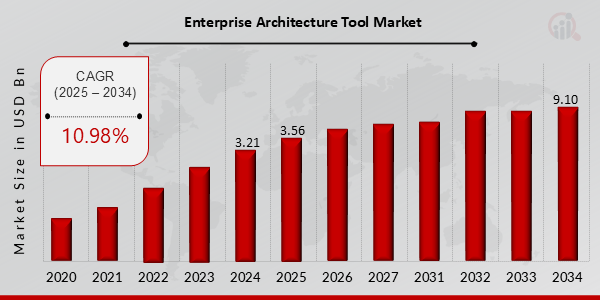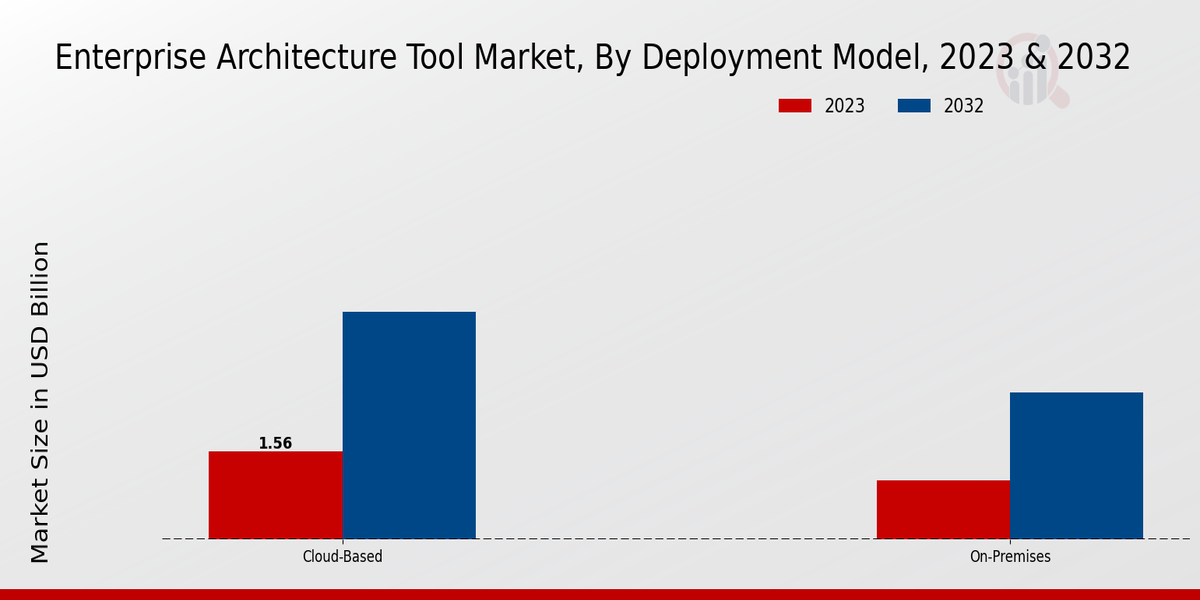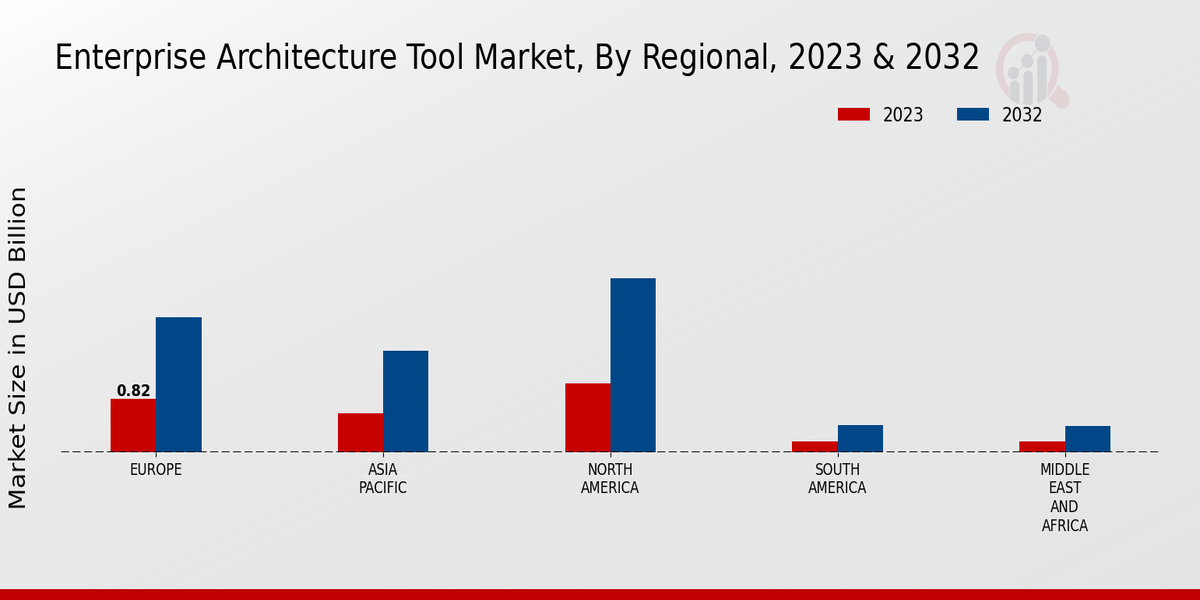Global Enterprise Architecture Tool Market Overview
Enterprise Architecture Tool Market Size was estimated at 3.21 (USD Billion) in 2024. The Enterprise Architecture Tool Market Industry is expected to grow from 3.56 (USD Billion) in 2025 to 9.10 (USD Billion) till 2034, exhibiting a compound annual growth rate (CAGR) of 10.98% during the forecast period (2025 - 2034)
Key Enterprise Architecture Tool Market Trends Highlighted
The Enterprise Architecture Tool Market is experiencing significant growth due to the rising need for organizations to align their IT infrastructure with business strategies. The adoption of cloud computing, digital transformation, and data-driven decision-making is driving demand for these tools. Advanced capabilities such as real-time analytics, predictive modeling, and integration with other enterprise applications are becoming essential.Key market drivers include the growing complexity of IT landscapes, increasing regulatory compliance requirements, and the need for improved agility and scalability. Organizations are also seeking tools that facilitate collaboration and communication among stakeholders, foster innovation, and support risk management.Recent trends in the Enterprise Architecture Tool Market include the emergence of cloud-based solutions, the integration of AI and machine learning, and the adoption of low-code/no-code platforms. Cloud-based tools offer scalability and flexibility, while AI and machine learning enhance automation and decision-making. Low-code/no-code platforms empower non-technical users to create and maintain architecture models, increasing accessibility and democratizing enterprise architecture.

Source: Primary Research, Secondary Research, MRFR Database and Analyst Review
Enterprise Architecture Tool Market Drivers
Accelerated Digital Transformation Driving Enterprise Architecture Tool Market Growth
Enterprise Architecture Tool Market Industry Over the past decade, the global industry has expanded significantly due to the rapid adoption of digital technologies in various sectors. Companies are increasingly realizing the importance of aligning their IT-related infrastructure with their business design to meet the needs of the ever-changing digitally-driven market. This type of tool provides a unified platform to plan, monitor, and manage complex information systems or complete IT arrangements, helping organizations meet the challenges of operationalizing their respective digital phenomena.The demand within the market domain is largely driven by the growing adoption of such tools that assist in the migration of existing IT resources to the cloud, investments in data integration, and the automation of processes. These requirements provide the flexibility, scalability, and efficiency necessary to convert a business’s IT core into a digital one. Another factor currently boosting the development of this industry is the transition to cloud-based service delivery.Finally, with the increasing spread of artificial intelligence and machine learning technologies, vast potential is noted within this sector, as these tools can significantly reduce manual work, improve decision-making, increase the quality of IT service provision, and provide a clearer understanding of IT configurations for more efficient utilization.
Increased Regulatory Compliance and Security Concerns Fueling Market Demand
Two major factors drive the demand for enterprise architecture tools: tight regulatory requirements and rising security concerns. With myriad and complicated compliance mandates, organizations are in need of a remedy that would enable them to control and then maintain their regulatory compliance. With respect to the security aspect, it is necessary to guard the IT assets of a particular organization against attacks conducted by malefactors. Enterprise architecture tools allow for the management of compliance and security activities in one room by delivering the platform for identifying risks and tracking the organizations’ compliance status.The above tools enable the IT teams of organizations to build comprehensive architecture diagrams and documentation. This, in turn, allows us to understand the nature of a particular IT infrastructure and the extent to which it fits the described regulatory requirements. Providing substantial support to compliance processes, enterprise architecture tools make organizations less vulnerable to penalties and enhance their security.
Rising Adoption of Agile and DevOps Methodologies
Enterprise architecture tools are increasingly being demanded due to the adoption of agile and DevOps methodologies. These methodologies focus on sharing, cooperation, continuous integration, and faster delivery of the IT solution. Enterprise architecture tools create a collaborative environment for stakeholders from both development and operations teams. They ,visualize and provide a clear picture of the IT architecture to understand the effects of any proposed changes.Overall, these tools improve decision-making by delivering easy-to-interpret architected data. Therefore, organizations can deploy these tools to enhance their software development processes, reduce delivery time, and improve the quality and trustworthiness of the IT solution.
Enterprise Architecture Tool Market Segment Insights
Enterprise Architecture Tool Market Deployment Model Insights
The Enterprise Architecture Tool Market revenue surrounding the Deployment Model has shown substantial growth opportunities, particularly driven by the shift in business operations toward digitalization. In 2023, the overall market for this segment was valued at 2.61 USD Billion. Among the various deployment methods, the Cloud-based model holds a significant position, valued at 1.56 USD Billion in the same year. This model is favored for its scalability, flexibility, and cost-effectiveness, which allows organizations to reduce infrastructure costs while gaining access to cutting-edge technologies.By 2032, the Cloud-based aspect is expected to reach 4.05 USD Billion, showcasing a significant growth trajectory as companies are increasingly adopting cloud solutions to enhance collaboration and streamline processes. On the other hand, the On-premises model had a valuation of 1.05 USD Billion in 2023 and is projected to grow to 2.61 USD Billion by 2032. While On-premises solutions offer greater control and security for sensitive data, this model is often less flexible compared to cloud alternatives, thus accounting for a comparatively smaller share in the overall Enterprise Architecture Tool Market segmentation.
The growing preference for Cloud-based solutions underlines a shift towards more modern deployment strategies, driven by the need for real-time data access and the ability to support a distributed workforce. The increase in remote work practices and the demand for agile IT solutions further promote the dominance of Cloud-based tools in the enterprise architecture space. Both deployment models present their unique advantages and challenges, with the Cloud model leading in market adoption due to its inherent advantages that align closely with the current business environment needs, while On-premises systems remain significant for industries requiring stringent compliance and security features.This dynamic landscape presents a plethora of growth drivers along with challenges, indicating evolving opportunities within the Enterprise Architecture Tool Market industry as businesses continue to navigate their digital transformation journeys.

Source: Primary Research, Secondary Research, MRFR Database and Analyst Review
Enterprise Architecture Tool Market Tool Type Insights
The Enterprise Architecture Tool Market is projected to be valued at 2.61 billion USD in 2023, with a significant increase expected by 2032. This market is diversified into various tool types, including Architecture Planning and Design, Architecture Governance and Compliance, Architecture Assessment and Analysis, and Architecture Repository and Management, each playing a crucial role in shaping enterprise strategies. Architecture Planning and Design tools are essential for aligning IT infrastructure with business goals, thus driving operational efficiency.On the other hand, Architecture Governance and Compliance ensures that organizations adhere to regulatory standards, which has become increasingly important in today’s digital environment. Architecture Assessment and Analysis tools support organizations in evaluating their current architecture and identifying areas for improvement, while Architecture Repository and Management services enable comprehensive documentation and management of architecture assets. The robust demand across these categories reflects the growing emphasis on strategic alignment and governance in enterprise architecture, contributing to the overall market growth.As organizations seek to improve agility and streamline processes, the tools associated with Architecture Planning Design and Governance are expected to witness significant traction, highlighting their importance in the broader context of the Enterprise Architecture Tool Market data and statistics.
Enterprise Architecture Tool Industry Vertical Insights
The Enterprise Architecture Tool Market is currently valued at 2.61 USD Billion as of 2023 and is anticipated to grow significantly in the coming years. The industry vertical plays a crucial role in this growth, as various sectors adopt enterprise architecture tools to improve their operational efficiency and strategic alignment. In the BFSI sector, the need for regulatory compliance and risk management drives adoption, ensuring robust decision-making processes. IT and Telecom benefit from these tools by enhancing their agility and innovation capabilities, which are crucial for adapting to market changes.Manufacturing utilizes enterprise architecture to streamline production processes, thereby reducing costs and improving supply chain management. The Healthcare sector relies on these tools to effectively manage patient data and improve service delivery, making it an essential component in this highly regulated industry. Government and Public Sector agencies leverage enterprise architecture to optimize resource management and enhance service delivery to citizens. Overall, the Enterprise Architecture Tool Market segmentation reflects a diverse range of applications across these industries, showcasing the critical role of enterprise architecture in modern business strategies.The expected market growth is driven by evolving technological advancements and increasing demand for digital transformation across these vital sectors.
Enterprise Architecture Tool Market Organization Size Insights
The Enterprise Architecture Tool Market, valued at 2.61 USD Billion in 2023, is characterized by its division into different Organization Sizes, including Small and Medium-sized Enterprises (SMEs) and Large Enterprises. The growth of the market is significantly driven by the increasing adoption of innovative technologies, which encourage companies of various sizes to implement architecture tools for better efficiency and strategic alignment. SMEs often represent a majority holding in this segment due to their agility and adaptability, enabling them to leverage enterprise architecture to streamline processes and enhance decision-making. Large Enterprises also play a vital role, as they require robust frameworks to manage complex structures and ensure alignment across various departments, thereby dominating the market in terms of spending power and resource allocation. The Enterprise Architecture Tool Market data reflects a trend towards a greater emphasis on digital transformation, where both segments are taking advantage of cloud-based solutions to facilitate improved collaboration and scalability. However, challenges such as budget constraints among SMEs and integration issues faced by larger organizations may impact growth, presenting opportunities for tailored solutions that address specific needs.The potential for increased efficiency and strategic advantage in both segments makes the Enterprise Architecture Tool Market statistics compelling for stakeholders.
Enterprise Architecture Tool Market Use Case Insights
The Enterprise Architecture Tool Market, valued at 2.61 USD Billion in 2023, shows strong potential for significant growth within various use cases, including IT Modernization, Digital Transformation, Business Process Optimization, and Regulatory Compliance. IT Modernization has been crucial in driving the adoption of these tools as organizations seek to update and streamline their technology landscapes, ensuring operational efficiency and reduced costs. Digital Transformation continues to accelerate as businesses embrace new digital technologies to enhance customer experience and stay competitive in the evolving market.Business Process Optimization is another key area as enterprises strive to improve their workflow and gain operational excellence, enabling nimble responses to market demands. Also, Regulatory Compliance holds a significant position as companies are increasingly focusing on compliance with evolving regulations and standards, ensuring risk management and governance. The demand for these focuses within the Enterprise Architecture Tool Market is further bolstered by extensive market growth trends and increasing investments in technology innovations, which play a pivotal role in shaping the landscape of the industry.Overall, the market segmentation reflects a diverse range of applications, where the synergy between these use cases drives the momentum of the Enterprise Architecture Tool Market.
Enterprise Architecture Tool Market Regional Insights
The Enterprise Architecture Tool Market revenue is projected to exhibit strong growth across various regions, with North America leading the charge. Valued at 1.05 USD Billion in 2023 and expected to rise to 2.66 USD Billion by 2032, North America dominates the market, owing to a significant presence of technology firms and a growing shift towards digital transformation. Europe follows, with a market valuation of 0.82 USD Billion in 2023, driving innovation in enterprise architecture. The Asia Pacific region is also emerging, with a current valuation of 0.6 USD Billion that is set to increase to 1.55 USD Billion, highlighting its potential as a future growth driver in the Enterprise Architecture Tool Market.Meanwhile, South America holds a smaller market share with 0.16 USD Billion, though growth to 0.41 USD Billion is anticipated, reflecting increased adoption in the region. The Middle East and Africa remain the least dominant, with a valuation of 0.16 USD Billion in 2023, but this is expected to grow to 0.4 USD Billion as enterprises recognize the importance of strategic planning and architecture in complex business environments. This diverse geographic landscape showcases the Enterprise Architecture Tool Market Statistics, emphasizing varying opportunities, challenges, and technological advancements that drive the industry forward.

Source: Primary Research, Secondary Research, MRFR Database and Analyst Review
Enterprise Architecture Tool Market Key Players And Competitive Insights
The Leading Enterprise Architecture Tool Market players pay much attention to the research and development that can help them stay ahead of the competition. Sparx Systems, for example, recently introduced a new version of Enterprise Architect, which includes several new features. In particular, the new Enterprise Architect includes improved modeling capabilities, enhanced reporting, and better integration with other tools such as Atlassian Jira. Sparx Systems is one of the largest and most innovative companies in the industry that provides a wide range of services and products for the entire enterprise architecture lifecycle. The flagship product of the company is Enterprise Architect, used by over 500,000 professionals worldwide to design, analyze, and manage complex enterprise architectures. Sparx Systems is also one of the most innovative and customer-oriented companies on the market. It is committed to providing the best products and services for its clients and is constantly updating and improving the tools available to adapt to the needs of an ever-changing market.Mega International is another Leading Enterprise Architecture Tool Market Player. The company’s MEGA Suite is one of the leading enterprise architecture platforms used by some of the world’s largest and most respected organizations. The MEGA Suite provides a range of tools and services to help organizations plan, design, implement, and manage different aspects of enterprise architecture. Mega International has a strong global presence.
Key Companies in the Enterprise Architecture Tool Market Include
- BiZZdesign
- Software AG
- Micro Focus International
- Oracle Corporation
- AVEVA Group
- Alfabet Inc.
- Planview, Inc.
- Gartner, Inc.
- IBM Corporation
- MEGA International
- SoftwareONE
- Schneider Electricc
- TIBCO Software
- Sparx Systems
- Fujitsu
Enterprise Architecture Tool Industry Developments
The Enterprise Architecture Tool market is poised to witness significant growth in the coming years. In 2023, the market was valued at USD 2.61 billion and is projected to reach USD 6.66 billion by 2032, exhibiting a CAGR of 10.98% during the forecast period. This growth can be attributed to the increasing adoption of digital transformation initiatives and the need for organizations to align their IT infrastructure with business strategies. The market is witnessing the emergence of new technologies such as artificial intelligence (AI) and machine learning (ML), which are expected to further drive growth in the coming years. Key players in the market include IBM, Oracle, SAP, and Software AG. Recent news developments include the launch of new products and services, such as IBM's Enterprise Architecture Management solution and Oracle's Enterprise Architecture Cloud Service.
Enterprise Architecture Tool Market Segmentation Insights
Enterprise Architecture Tool Market Deployment Model Outlook
Enterprise Architecture Tool Market Tool Type Outlook
- Architecture Planning and Design
- Architecture Governance and Compliance
- Architecture Assessment and Analysis
- Architecture Repository and Management
Enterprise Architecture Tool Market Industry Vertical Outlook
- BFSI
- IT and Telecom
- Manufacturing
- Healthcare
- Government and Public Sector
Enterprise Architecture Tool Market Organization Size Outlook
- Small and Medium-sized Enterprises (SMEs)
- Large Enterprises
Enterprise Architecture Tool Market Use Case Outlook
- IT Modernization
- Digital Transformation
- Business Process Optimization
- Regulatory Compliance
Enterprise Architecture Tool Market Regional Outlook
- North America
- Europe
- South America
- Asia Pacific
- Middle East and Africa
|
Report Attribute/Metric
|
Details
|
|
Market Size 2024
|
USD 3.21 Billion
|
|
Market Size 2025
|
USD 3.56 Billion
|
|
Market Size 2034
|
USD 9.10 Billion
|
|
Compound Annual Growth Rate (CAGR)
|
10.98% (2025-2034)
|
|
Base Year
|
2024
|
|
Market Forecast Period
|
2025-2034
|
|
Historical Data
|
2020-2023
|
| Market Forecast Units |
USD Billion |
|
Report Coverage
|
Revenue Forecast, Competitive Landscape, Growth Factors, and Trends
|
| Key Companies Profiled |
BiZZdesign, Software AG, Micro Focus International, Oracle Corporation, AVEVA Group, Alfabet Inc., Planview, Inc., Gartner, Inc., IBM Corporation, MEGA International, SoftwareONE, Schneider Electricc, TIBCO Software, Sparx Systems, Fujitsu |
| Segments Covered |
Deployment Model, Tool Type, Industry Vertical, Organization Size, Use Case, Regional |
| Key Market Opportunities |
Digital transformation Cloud computing Big data analytics Business process optimization IT modernization |
| Key Market Dynamics |
Rising cloud adoption Growing data volumes Need for agility and flexibility Increasing adoption of digital technologies Government regulations and compliance. |
| Countries Covered |
North America, Europe, APAC, South America, MEA |
Frequently Asked Questions (FAQ) :
The Enterprise Architecture Tool Market is expected to reach a value of 9.10 USD Billion in 2034.
The market is anticipated to grow at a CAGR of 10.98% from 2025 to 2034.
North America is expected to hold the largest market share, valued at 2.66 USD Billion in 2032.
The cloud-based deployment segment is projected to reach 4.05 USD Billion in 2032.
The on-premises segment is expected to reach a value of 2.61 USD Billion in 2032.
Europe is expected to reach a market size of 2.06 USD Billion by 2032.
Key players include BiZZdesign, Software AG, Oracle Corporation, Gartner, and IBM Corporation.
The Asia Pacific region is projected to be valued at 1.55 USD Billion in 2032.
The market size for South America is anticipated to be 0.41 USD Billion in 2032.
The market may face challenges such as rapid technological advancements and changing customer requirements.

















